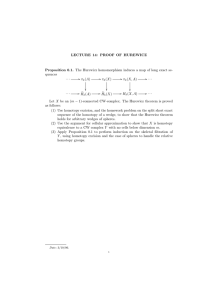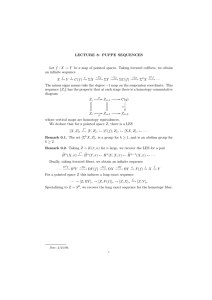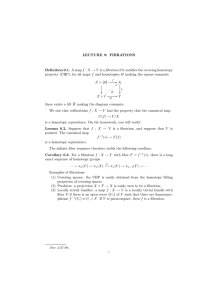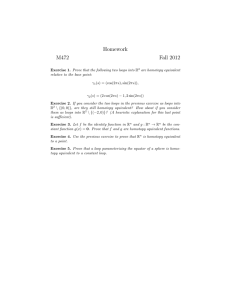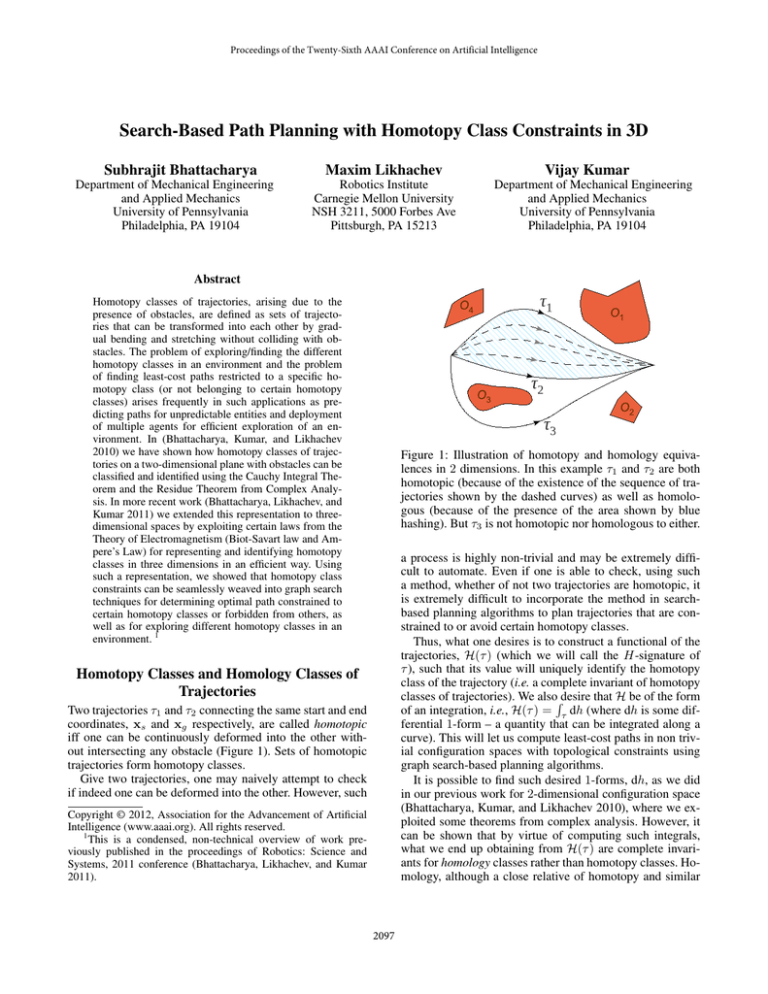
Proceedings of the Twenty-Sixth AAAI Conference on Artificial Intelligence
Search-Based Path Planning with Homotopy Class Constraints in 3D
Subhrajit Bhattacharya
Department of Mechanical Engineering
and Applied Mechanics
University of Pennsylvania
Philadelphia, PA 19104
Maxim Likhachev
Robotics Institute
Carnegie Mellon University
NSH 3211, 5000 Forbes Ave
Pittsburgh, PA 15213
Vijay Kumar
Department of Mechanical Engineering
and Applied Mechanics
University of Pennsylvania
Philadelphia, PA 19104
Abstract
Homotopy classes of trajectories, arising due to the
presence of obstacles, are defined as sets of trajectories that can be transformed into each other by gradual bending and stretching without colliding with obstacles. The problem of exploring/finding the different
homotopy classes in an environment and the problem
of finding least-cost paths restricted to a specific homotopy class (or not belonging to certain homotopy
classes) arises frequently in such applications as predicting paths for unpredictable entities and deployment
of multiple agents for efficient exploration of an environment. In (Bhattacharya, Kumar, and Likhachev
2010) we have shown how homotopy classes of trajectories on a two-dimensional plane with obstacles can be
classified and identified using the Cauchy Integral Theorem and the Residue Theorem from Complex Analysis. In more recent work (Bhattacharya, Likhachev, and
Kumar 2011) we extended this representation to threedimensional spaces by exploiting certain laws from the
Theory of Electromagnetism (Biot-Savart law and Ampere’s Law) for representing and identifying homotopy
classes in three dimensions in an efficient way. Using
such a representation, we showed that homotopy class
constraints can be seamlessly weaved into graph search
techniques for determining optimal path constrained to
certain homotopy classes or forbidden from others, as
well as for exploring different homotopy classes in an
environment. 1
Figure 1: Illustration of homotopy and homology equivalences in 2 dimensions. In this example τ1 and τ2 are both
homotopic (because of the existence of the sequence of trajectories shown by the dashed curves) as well as homologous (because of the presence of the area shown by blue
hashing). But τ3 is not homotopic nor homologous to either.
a process is highly non-trivial and may be extremely difficult to automate. Even if one is able to check, using such
a method, whether of not two trajectories are homotopic, it
is extremely difficult to incorporate the method in searchbased planning algorithms to plan trajectories that are constrained to or avoid certain homotopy classes.
Thus, what one desires is to construct a functional of the
trajectories, H(τ ) (which we will call the H-signature of
τ ), such that its value will uniquely identify the homotopy
class of the trajectory (i.e. a complete invariant of homotopy
classes of trajectories). We alsoRdesire that H be of the form
of an integration, i.e., H(τ ) = τ dh (where dh is some differential 1-form – a quantity that can be integrated along a
curve). This will let us compute least-cost paths in non trivial configuration spaces with topological constraints using
graph search-based planning algorithms.
It is possible to find such desired 1-forms, dh, as we did
in our previous work for 2-dimensional configuration space
(Bhattacharya, Kumar, and Likhachev 2010), where we exploited some theorems from complex analysis. However, it
can be shown that by virtue of computing such integrals,
what we end up obtaining from H(τ ) are complete invariants for homology classes rather than homotopy classes. Homology, although a close relative of homotopy and similar
Homotopy Classes and Homology Classes of
Trajectories
Two trajectories τ1 and τ2 connecting the same start and end
coordinates, xs and xg respectively, are called homotopic
iff one can be continuously deformed into the other without intersecting any obstacle (Figure 1). Sets of homotopic
trajectories form homotopy classes.
Give two trajectories, one may naively attempt to check
if indeed one can be deformed into the other. However, such
Copyright © 2012, Association for the Advancement of Artificial
Intelligence (www.aaai.org). All rights reserved.
1
This is a condensed, non-technical overview of work previously published in the proceedings of Robotics: Science and
Systems, 2011 conference (Bhattacharya, Likhachev, and Kumar
2011).
2097
G
ζb
vg
ζa
ζκ1
vs
τ2
ζκ
2
ζc
(a) A torus-shaped (b) A genus 2 obsta- (c) A solid cube
genus 1 obstacle.
cle.
does not induce
homotopy classes.
τ1
S
Figure 3: Examples of obstacles in 3-D. (a-b) induce homotopy classes, (c) does not.
(a) In same Homotopy (b) In different Homoclass, forming a closed topy classes, enclosing
contour
obstacles
Si
Si
Figure 2: Two trajectories in same and different homotopy
classes in 2 dimensions
vg
vs
to it in many aspects, is subtly different from homotopy.
Two trajectories τ1 and τ2 connecting the same start and end
coordinates, xs and xg respectively, are homologous iff τ1
together with τ2 (the later with opposite orientation) forms
the complete boundary of a 2-dimensional region embedded
in the configuration space not containing/intersecting any of
the obstacles (Figure 1).
It can in fact be shown that homotopic trajectories are always homologous (equivalently, trajectories that are not homologous are not homotopic either), but the converse may
not always be true. However, the difference between the two
appear infrequently in practical robot configuration spaces,
and as we demonstrate through our results, homology serves
as a fair analog of homotopy in most practical robotics problems.
Sj
(a) Skeleton of a generic
genus 1 obstacle is modeled
as a current-carrying conductor, Si .
(b) Theorems from electromagnetism then gives us homotopy class invariants for
trajectories.
Figure 4: Skeletons of obstacles in 3-D are modeled as current carrying conductor.
H-signature in 3-D
Just as we exploited theorems from complex analysis in 2
dimensions for constructing the homotopy class invariants,
we can exploit certain theorems from Electromagnetism to
achieve the same in 3 dimensions. In 3 dimensions multiple homotopy classes can only be induced by obstacles with
genus 2 one or more, or with obstacles stretching to infinity.
Figure 3 shows some examples of obstacles that can or cannot induce such classes for trajectories. A sphere or a solid
cube, for example, cannot induce multiple homotopy classes
in an environment.
Analogous to the representative points in the 2dimensional case, in 3 dimensions we need to consider
closed curves that represent the obstacles of genus 1 or
higher (Figure 4(a)). These curves are the skeletons of the
obstacles – 1-dimensional curves that are homotopy equivalents (Hatcher 2001) of the obstacles. We represent these
skeletons by Si , where i = 1, 2, · · · , M .
The key idea in designing a H-signature for solid obstacles in 3-dimensions is to model these skeletons of the obstacles as “virtual conductors” carrying unit current. Upon doing so, using the Biot-Severts Law and Ampere’s Law (Griffiths 1998), one can design the H-signature for trajectories
τ in 3-dimensions as follows,
B1 (l)
Z
B2 (l)
dl
H3 (τ ) =
(2)
..
.
H-signature as Topological Invariants
Background: H-signature in 2-D
The basic principle (Bhattacharya, Kumar, and Likhachev
2010) in solving the problem in 2-dimensions was based
on the Residue Theorem from Complex Analysis. We represented the two dimensional plane in which the robot’s path
is to be planned by the complex plane (i.e. a point (x, y) on
it is represented as z = x + iy). We hence defined the Hsignature (which we previously called the L-value in (Bhattacharya, Kumar, and Likhachev 2010)) of a trajectory, τ ,
as a complex path integral of a complex vector function as
f1 (z)
follows,
z−ζ1
Z f2 (z)
z−ζ2
dz
H2 (τ ) =
(1)
..
τ
.
fM (z)
z−ζM
The quantity inside the integration (a complex vector) is an
analytic function everywhere in the complex plane, except
for distinct points, ζi , which we called representative points,
placed on the obstacles (Figure 2), where the function has
poles. As a consequence of this it could be shown using
Residue Theorem that for two trajectories τ1 and τ2 connecting the same start and goal points in a 2-dimensional
configuration space, H2 (τ1 ) = H2 (τ2 ) if the trajectories are
in the same homotopy class, but the values are different if
they are in different homology classes.
τ
BM (l)
2
The genus of an obstacle refers to the number of holes or handles (Munkres 1999).
2098
where,
Bi (r) =
1
4π
Z
Si
(x − r) × dx
kx − rk3
(3)
is a “virtual magnetic field vector” due to the virtual current flowing through the skeletons. Using Biot-Severts Law
and Ampere’s Law, it can be shown that for two trajectories
τ1 and τ2 connecting the same start and goal points in a 3dimensional configuration space, H3 (τ1 ) = H3 (τ2 ) if the
trajectories are in the same homotopy class, but the values
are different if they are in different homology classes (Figure 4(b)).
(a) Two hoops.
(b) A room with windows.
Incorporating H-signature in Graph-search Based
Algorithms
Having designed a H-signature for 3-dimensional configuration spaces in form of an integral, the approach in graph
search-based planning is very similar to the one we adopted
in (Bhattacharya, Kumar, and Likhachev 2010). We construct an augmented graph from the given discrete graph
representation of the environment, such that each vertex in
this new graph has the H-signature of a path leading up to
the coordinate of the vertex from vs (start vertex) appended
to it. The consequence of augmenting each vertex of original graph, G, with a H-signature is that now vertices are
distinguished not only by their coordinates, but also the Hsignature of the trajectory followed to reach it. Since the
H-signature is in form of an integration, during expansion
of the vertices in the search algorithm, its value for newly
expanded vertices can be easily computed by adding to the
value of its parent the H-signature of the edge connecting
them. Planning trajectories in this augmented graph thus allows us impose constraints on the H-signature of the desired
trajectories as well as find optimal trajectories in different
homotopy classes in the environment. For more details on
the graph construction the reader may refer to (Bhattacharya,
Likhachev, and Kumar 2011).
(c) Exploring 10 distinct ho- (d) Plan in the complemenmotopy classes.
tary homotopy class of the
least cost path.
Figure 5: Exploring homotopy classes and planning with Hsignature constraints (Bhattacharya 2012).
For more details, results in other interesting configuration spaces (including one in X − Y − T ime) as well as
for higher dimensional extensions, please see (Bhattacharya,
Likhachev, and Kumar 2011) and (Bhattacharya 2012).
References
Bhattacharya, S.; Kumar, V.; and Likhachev, M. 2010.
Search-based path planning with homotopy class constraints. In Proceedings of the Twenty-Fourth AAAI Conference on Artificial Intelligence.
Bhattacharya, S.; Likhachev, M.; and Kumar, V. 2011. Identification and representation of homotopy classes of trajectories for search-based path planning in 3d. In Proceedings
of Robotics: Science and Systems.
Bhattacharya, S. 2012. Topological and Geometric Techniques in Graph Search-based Robot Planning. Ph.D.
Dissertation, University of Pennsylvania, Philadelphia, PA,
USA. Supervisors – Vijay Kumar and Maxim Likhachev.
Griffiths, D. J. 1998. Introduction to Electrodynamics (3rd
Edition). Benjamin Cummings.
Hatcher, A. 2001. Algebraic Topology. Cambridge University Press.
Munkres, J. 1999. Topology. Prentice Hall.
Results
Figure 5(a)-(c) shows examples where we find least cost
trajectories in different homotopy classes in a few environments by searching in the the augmented graphs. In each
of these simulations there were certain pre-computations involved, where we computed the H-signature for every edge
in the original graph. This pre-computation, that needs to be
performed only once for a given environment, takes about
15 minutes. The searches in the augmented graphs for finding trajectories in different homotopy classes itself took less
than a minute.
Figure 5(d) demonstrates a planning problem with Hsignature constraint. The darker trajectory is the global least
cost path found from a search in the original graph for the
given start and goal coordinates. The H-signature for that
trajectory was computed, and hence we computed the signature of the complementary class (i.e the class corresponding
to the trajectory that passes on the other side of every obstacle). The lighter trajectory is the one planned with that
H-signature as constraint. Thus, this trajectory goes on the
opposite side of each and every pipe in the environment as
compared to the darker trajectory.
2099



